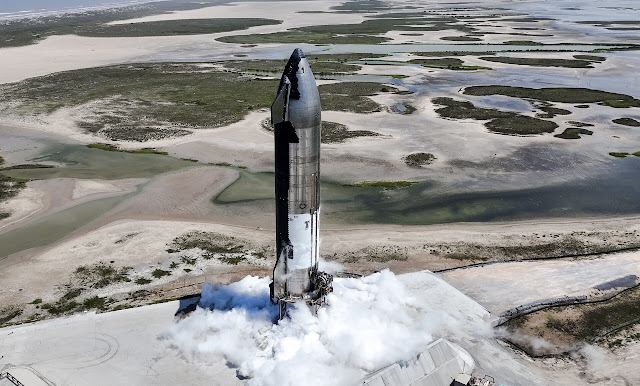Granted, I don't know how many steps there are before the second Integrated
Flight Test, after the April 20th 1st test, but five days after
last Wednesday's cryo testing, yesterday was an important milestone: a six engine, six second static
firing of Ship 25.
Endless video loop here. What appears to be moments before the start is here. (Six seconds is a SWAG - SiG)
Today, Ars Technica gave a bit of rundown on a few of the “well over a thousand” changes Elon Musk claims have been made to the Starship and Super Heavy itself as well as the Orbital Launch Mount or OLM. We talked about one of the biggest changes, staging differently last week as well.
SpaceX is adding an extension to the top of the Super Heavy booster with vents to allow super-hot gas from the upper stage engines to safely flow out of the rocket’s structure “and not just blow itself up,” Musk said. “This is the most risky thing, I think, for the next flight.”
Probably the next big change in this area is changing from the mechanical thrust vector control (TVC) of the older Raptors on the IFT1 to all of the Raptors on Booster 9 having the electrically driven TVC. They've also added stronger shielding around each of B9’s 33 Raptor engines to protect them from explosions of nearby engines, a measure intended to reduce the chance of cascading failures.
For the Starship’s second test flight, SpaceX teams are modifying manifolds on the Raptor engines that direct hot methane-rich gas toward each engine’s combustion chamber for mixing with oxygen-rich gas. The previous design was susceptible to leaks, where the hot gas could seep through bolt holes used to attach the manifold to the engine. Engineers will introduce an improved manifold design and add more torque to bolts to address the concern about leakage of super-heated gas.
Then there's the ground infrastructure, what Musk calls Stage Zero. If you've watched any of the update videos, you've seen them adding many rebar cages for poured concreted deep under the OLM. In addition, they've poured nearly 1,000 cubic meters of concrete underneath the launch pad’s pedestal, and over the steel-reinforcing cages.
SpaceX will install two thick steel plates on top of the new layer of reinforced concrete, with channels routed through them to allow water to flow through and shoot out the top.
“Think of it like a gigantic upside-down shower head,” Musk said. “It’s basically going to blast water upwards while the rocket is over the pad to counteract the massive amount of heat from the booster.”
These few changes clearly aren't even 10% of the changes to the system if it's really over a thousand of them. The big ones concern really understanding the rocket; “resolve the unknowns” that remain, many of which can’t be fixed until engineers gather data from an actual launch. Reality brings that nagging reminder that they need to go through the process of getting FAA approval of their Flight Termination System again, since it took longer than expected to destroy the vehicle during the first IFT. The "longer than expected" time to work wasn't an issue since the vehicle was 24 miles above the Gulf of Mexico and nowhere near a populated area. That might not matter to the FAA at all.
Musk acknowledged Saturday that it may not be up to SpaceX when the next Starship test launch happens. “There are a lot of variables here that are outside of our control.”

I hope they've thought that one out . . . I could see several issues.
ReplyDeleteSpaceX does not hire off-the-shelf-fresh-out-of-College idiots, so lots of these changes a subtle, few are major. Hot staging works for the Russians, SpaceX is not afraid to give it a go.
DeleteDesign, build, launch (test), analyze any failures. Repeat as necessary. If it's a stoopid idea but it works, it ain't stoopid!
Was really thinking more about the upshot water at the pad. If the Russians can do hot staging, Elon can. The fact that they tore up the pad so badly means that they have engineering design ignorance there.
DeleteHot staging gets a 10% improvement in mass to orbit? WOW! That is a huge, huge improvement. I'm a bit surprised they haven't been doing it that way from the start, but now is a good time to make the change before they start mass-producing Boosters and Starships
ReplyDeleteSomething that surprised me about that was mentioned in the Ars Technica article (link right under the picture of Starship).
Delete"Russian rockets, like the venerable Soyuz, have employed the hot staging technique for decades..." Which kinda makes me want to say, "how hard can it be?" - one of the most terrifying sayings in all of engineering. Right along with "all you gotta do...".
Hot staging over an expendable booster is a proven technology but doing it to the same Booster over and over again is another level of difficulty entirely. If they CAN do it and reuse the booster with extra maintenance they may make it an optional feature like expending a booster section to get maximum mass to orbit.
DeleteFor the hot staging, will SpaceX turn on the engines sequentially and at lower power instead of everything full power all at once?
ReplyDeleteOnce SpaceX is confident they have worked out the problems, any idea if they plan on anything like launching a car and mannequin again?
Musk mentioned that three sea-level raptors will fire at 30% initially.
DeleteThank you Igor
Delete